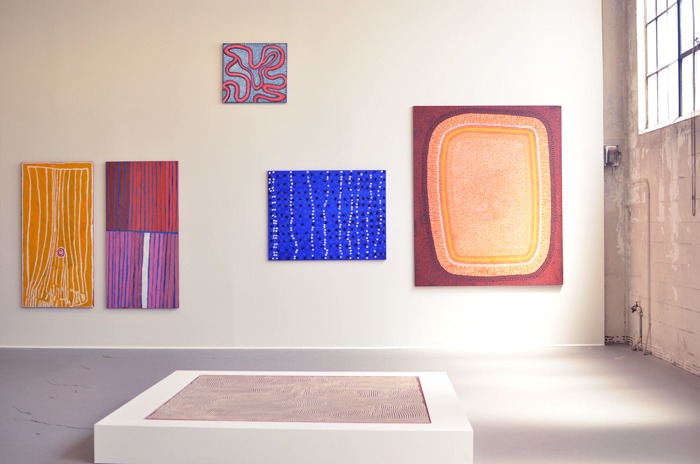A Case For Abstraction: No Boundaries
Amy Bernstein
Originally published by PORT July 30, 2015

Forgive me.
In the middle of summer, this review is late. The heat this year is thick and heavy, wrapping around me like a needy lover. The days are long and drowsy, and the passing of time is difficult to feel. The ground beneath my feet is sharp and thirsty and flammable, while my body is the source of a river of sweat that makes a salty warm waterfall of my person. I am a waterfall person. I walk through this duality, my thoughts punctuated by the intermittent beeps of my cellphone. The neural pathways these beeps have been digging into my brain have created an attention span reminiscent of a hummingbird. My heart races as my brain flits from thing to thing to thing: what is in front of me, what is in the ether of my mind. Very little is completed or retained. As the hummingbird, I miss the existence of the elephant standing in front of me. So slow and steady is the rhythm of his heartbeat that I cannot recognize him as a facet of my reality and thus, he is not. I miss my chance to see him.
All I want is to see him.
This hot day in this hot time is heaped upon my ancient DNA, carving a small and sweaty notch. I drink water to begin and to continue. It glides down my throat, thick with minerals shed from the bodies of dying stars. These stars enter into my bones and my blood, making them glow. I walk around this place, upheld only by the grace of history, chance, and a collection of star deaths.
What does this existence look like? What form could I use to tell you that you are not alone? What picture would show you that what I am is where I’ve come from and where I’ve been, but also where I am? What shape would let you know that your bones and mine are made of the same stars? That there are, essentially, no boundaries between us?

PICA’s No Boundaries exhibition brings together the work of nine painters to represent the state of Aboriginal Australian Contemporary Abstract image making. These works are raw and complex inventions that hang in the space like oracles. They are prophetic beacons that buck contemporary modes of sarcasm and irony and instead operate out of a position of generosity. Rich with color and texture, they tell stories from the longest continuous culture on earth, while maintaining a fierce relevance in this time, one of the most plural art contexts society has ever seen.
Walking into the exhibition space, I am met by a group of strange peers in the form of paintings. We are painters. We have not met before, but they speak in ways that I understand and with a wisdom that I did not know existed. They tell me that formal elements still hold an unearthly power even in such an advanced technological age and that real time is a clock marked only by birth and death. They say that to be honest in the depiction of nature is to be honest to its endless nuance and tangled complexity. They say that stylization is insufficient in the accuracy of its account; to make a rough map is to send someone in the wrong direction. They say that human rhythm is not of an exact meter but in fact imprecise. They say that color is a choice that demands attention.

These days are days in which the horizon line holds less weight. The line thought to hold balance and grant orientation is a pictoral cultural construct. The sun marks the beginning and end of the day, but dictates the character of a day by
the way it feels on the skin, whether the plants prosper, and the color of its light at different points in the season or on the globe. Gravity holds us fast to the earth and determines the paths of planets. On a picture plane, cardinal direction and the notion of gravity are only ways in which we depict our physical existence; they are ways in which we depict what we see in front of our own vertical bodies as they stand on the relatively horizontal ground beneath us. And yet, here, on the picture plane, we have a stage without rules. What does existence look like here? A gravity-bound reality is insufficient; instead these works instruct in spiritual symbol.

These works are not constructs and therefore answer to no hierarchy of knowledge; there is no canon by which they must proceed from, balk, or answer to. There is only the inherent power of the Dreaming which must be evoked by the marks therein. It chooses to live in a world of spirits, exercising what Gulumbu Yunupingu’s son-in-law, Will Stubbs, describes as “soft power”. It is a shared mythology that has individual iterations in paint, a bible written in form by its readers whose stories live in the land and the water and the sky.


On the wake and tide of spiritual symbolism, we spend these days examining what we can no longer stand, how we must see differently. The rainbow flag comes up, and the confederate flag comes down. We use a hashtag to indicate significance, a new exclamation point without sound. Subversion can be a shockingly simple choice; within the lone act of breaking habit, one can exist differently. The paintings of No Boundaries are instructions in a peripheral philosophy, one in which the spiritual world is unifying and abstraction is apropos.
No Boundaries is free and open to the public at the Mason Ehrman Building Annex at NW 5th and Davis. It will be on view until August 16.
